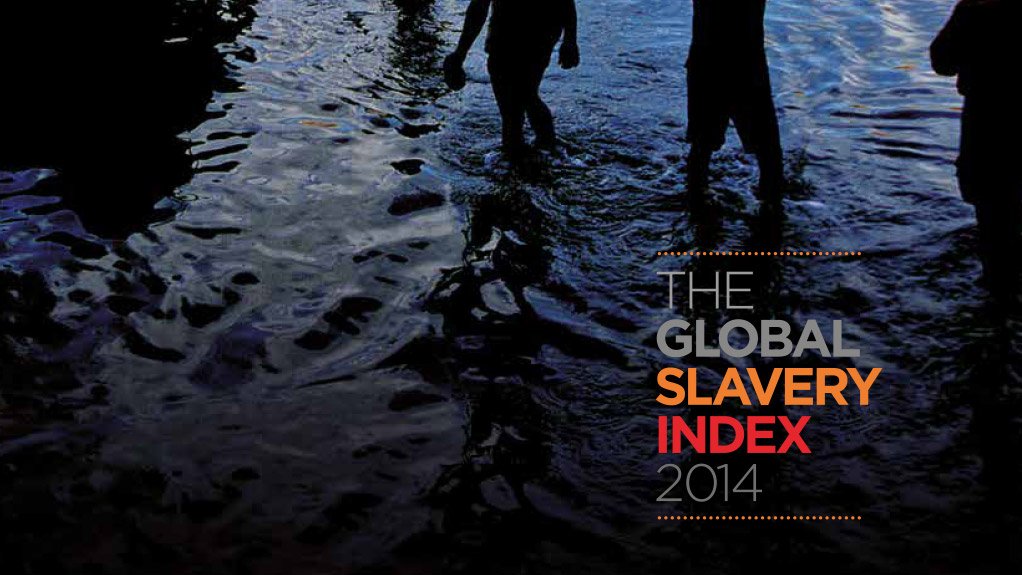- 2014 Global Slavery Index (Please note: Large download)7.09 MB
An estimated 35.8-million men, women and children around the world are today trapped in modern slavery, 20.13% more than previously estimated, whether through human trafficking, forced labour, debt bondage, forced or servile marriage, or commercial sexual exploitation. This is according to the 2014 Global Slavery Index (GSI), the flagship research report published today by the Walk Free Foundation, a global human rights organisation with a mission to end modern slavery in a generation.
The report looks at prevalence (the percentage of a country’s population that is enslaved) as well as the total number of people living in modern slavery in each country. In sub-Saharan Africa, over 5.6-million people are estimated to be trapped in modern slavery, representing almost 16% of the global total. With 4% of its population, Mauritania has the highest prevalence of modern slavery not just in the Africa, but also globally. The Democratic Republic of the Congo, Sudan and the Central African Republic come next in prevalence, with 1.13% each.
Looking at absolute numbers Nigeria has the highest number of people living in modern slavery (834,200) followed by the DRC (762,900) and Ethiopia (389,700). Madagascar followed by Kenya and South Africa have the lowest level of prevalence in the region, although the number of people living in modern slavery in South Africa is still estimated to be in excess of 100,000 people.
In sub-Saharan Africa complex patterns of migration are fuelled by economic hardship, conflict and climate disasters, pushing migrants to urban areas, more prosperous African nations such as South Africa and Kenya, to Europe and to the Gulf. Internal and foreign migrants are vulnerable to exploitation as they lack the protection of labour laws and access to social services. Sub-Saharan African countries plagued by conflict and political instability have generally higher prevalence of modern slavery, where children are often forced into armed ranks. Countries with vast mineral resources also see significant numbers of men and boys forced to work in mines.
On the positive side, all countries in the region have domestic legislation in place to address modern slavery, and 35 countries also have coordination bodies working on modern slavery issues. Eight countries in the region – including Mauritania – have a clear budget allocation to address modern slavery.
While the Index estimates that 20.13% more people are enslaved than reported in 2013, rather than reflecting an exponential rise in the number enslaved over the past, this significant increase is due to enhanced data and methodology. This includes national representative surveys in some of the countries worst afflicted.
Commenting on the report’s findings, Andrew Forrest, Chairman and Founder of Walk Free Foundation, said: “There is an assumption that slavery is an issue from a bygone era. Or that it only exists in countries ravaged by war and poverty. These findings show that modern slavery exists in every country. We are all responsible for the most appalling situations where modern slavery exists and the desperate misery it brings upon our fellow human beings. The first step in eradicating slavery is to measure it. And with that critical information, we must all come together – governments, businesses and civil society – to finally bring an end to the most severe form of exploitation”
An innovation of the 2014 Global Slavery Index is its inclusion of government actions in relation to modern slavery. For the first time, the GSI provides an analysis of government responses based on five objectives that every country should seek to accomplish in order to eradicate modern slavery. These include identification and support for survivors, an appropriate criminal justice mechanism, coordination and accountability within central government, addressing the attitudes, social systems and institutions that facilitate modern slavery and finally government and business procurement.
“Modern slavery is a hidden crime and notoriously difficult to measure. But Walk Free Foundation is shining a light on this horrific crime with innovative research and each year an even stronger methodology. We are all grateful for Andrew Forrest’s commitment to this issue”, said Mo Ibrahim, founder of the Mo Ibrahim Index and Mo Ibrahim Foundation.
The Index gives the most accurate and comprehensive measure of the extent and risk of modern slavery. It provides an analysis of its prevalence in terms of the percentage of a national population and the total number of people enslaved – country by country, region by region.
The Global Slavery Index report can be downloaded above.
EMAIL THIS ARTICLE SAVE THIS ARTICLE
To subscribe email subscriptions@creamermedia.co.za or click here
To advertise email advertising@creamermedia.co.za or click here











